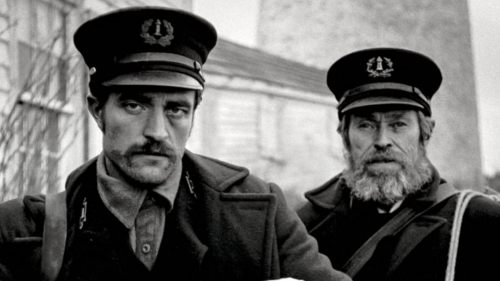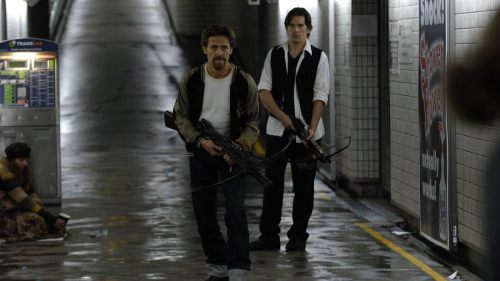TO LIVE AND DIE And Drive IN L.A.
William Friedkin has had one of the most fascinating careers in Hollywood. From his start directing one of the final episodes of The Alfred Hitchcock Hour to his three-year streak of The Boys in the Band, The French Connection and The Exorcist, from big-budget flops like Sorcerer and Deal of the Century to the gay-sex-and-violence controversy of 1980s' Cruising and the stylish cynicism of To Live and Die in L.A. (1985) and more recently, the psychodrama and comic horror of Bug and 2011’s Killer Joe, Friedkin demonstrates a talent as wide-ranging as it is singular.
To Live and Die in L.A. is a weird movie in a lot of great ways. It’s technically about the Secret Service but make no mistake - this is a cop movie and it’s got the clichés to prove it. There’s a young hotshot agent who breaks the rules and drinks too much, an older agent who says with total sincerity “I’m getting too old for this shit,” an Arab terrorist with a suicide bomb, a three-days-till-retirement speech, a hot blonde informant with an open bed and the inside scoop on criminal doings, and a slimy “artist” counterfeiter with a penchant for sexual ambiguity and arson (yes, he’s a flamer). Mixed in with all that is a depiction of the counterfeiting process so thorough the real Secret Service investigated the production, as well as glimpses of dancers painted like David Bowie album art. All in the first 15 minutes!
Did I mention the Wang Chung soundtrack featuring title track “To Live and Die in L.A.”? Because that happens, too.
Friedkin has said he doesn’t like to move the camera unless it’s motivated by action or an actor, so when an actor like William Petersen takes over the frame, it’s guaranteed to move. In his big screen premiere, Chicago stage actor Petersen brings a remarkable physicality to the role of Agent Richard Chance. Cocky, hotheaded and virtually incapable of staying still, he paces and prowls. He doesn’t sit on furniture so much as mount it. He walks with a bowlegged swagger so extreme it borders on parody. In the sex scene, it’s Petersen who goes full frontal (and not for any of that half-second Ben Affleck nonsense).
Petersen’s physicality really does guide the pace of the film. When he runs (which is often), the camera races alongside him. When he drives, the camera is in and on the car, swiveling constantly between the driver, his terrified passengers and the impossible road ahead. From the camera movements to the editing to the performances themselves, this is a movie that moves.
Petersen is contrasted against Willem Dafoe’s Eric Masters, a semi-successful artist turned counterfeiter who works hard and plays hard, painstakingly creating the best fake bills around, cruising in his Ferrari, hanging out with modern dancers and occasionally burning his own paintings. Dafoe has a great time sliding back and forth between sleazy and sincere. He’s always calm and doesn't hurt anyone without reason. Where Agent Chance is headstrong and belligerent, Masters is peaceful and speaks with respect. That said, Masters does kill people and with some regularity. Next to each other, it’s easy to tell which is the criminal and which is the fed; it’s not as easy to tell which is the good guy and bad guy.
As the movie progresses, Chance’s behavior gets more extreme. In his zeal to bust Masters, he begins committing crimes of his own, starting small (swiping evidence) and getting much bigger. It’s this spiral that leads to the centerpiece of the movie, the chase scene. Chance and his new partner have attempted to rob a jewelry buyer of $50,000 to prove to Masters they are legit. The robbery is interrupted and the courier is shot dead. Chance gets behind the wheel and the agents try to escape as unknown assailants with assault rifles converge on them.
The chase is one of those sequences that builds and lulls a few times before finally going completely insane. Chance escapes first by racing through a produce alley obstacle course. When more assailants find him, he loses them by racing across the front of a speeding train. Somehow, they find him again. This time, he escapes by driving into the LA canals. Suddenly bad guys are everywhere - they’re shooting from the sides of the canal and the overpasses - and even more cars arrive to give chase. This time Chance drives into street traffic to lose them and almost succeeds before being surrounded by cars and men with drawn weapons.
And then the insanity kicks in as Chance floors the gas pedal and heads the wrong way up a freeway on-ramp. Gesturing wildly at other cars and ignoring the sounds of hysteria coming from his traumatized partner in the back seat, Chance enters the goddamn freeway going the wrong way.
As Chance proceeds to haul ass the wrong way down a crowded LA freeway, his partner loses his mind completely. Visions of the man they just saw killed flash through his head as he moans and cries. Chance, though, is finally in the zone. He’s calm, almost zen-like, flashing back to the feeling of base-diving as he focuses on the endless wave of oncoming traffic headed against him.
Incredibly, the agents survive and make it off the freeway, but both are changed by the experience. Chance is convinced he’s unbeatable, immortal and above the law. As for his partner, he’s a mess and when he finally does recover, he’s a colder, tougher man, as though he’s absorbed some of Chance’s personality.
To this day, the chase scene is shocking. Friedkin knew from the beginning he wanted a sequence that would be different but similarly memorable to the one he had created in The French Connection. With stunt coordinator Buddy Joe Hooker, they put together the idea of a wrong-way freeway chase. It took six weeks to complete and was the final sequence of the movie to be filmed (supposedly in case anything happened to the talent during filming). To ensure the scene would be as intense and disorienting as possible, Friedkin and Hooker arranged for the oncoming traffic to drive on the left, British-style, while Petersen drove against them on the right, American-style (naturally, Peterson insisted on doing his own driving).
Friedkin had hired Dutch cinematographer Robby Müller after seeing his work with natural light and quick setups on Wim Wenders movies, particularly Paris, Texas. For the most part, their styles meshed well and the movie’s sun-bleached look is one of its most identifiable traits. Nonetheless, when it came time to film the chase, Müller refused, saying he had no idea how to stage something like that. Second unit camera man Robert Yeoman stepped up and helmed the chase sequence and he knocked it out of the park. Viewpoints alternate from inside the car to alongside it, in front of and behind it. The framing makes it clear that Peterson really is driving while fellow Chicago stage actor John Pankow cowers in the backseat. Occasionally, the camera will lift up above the car enough to reveal hundreds of cars on a huge stretch of freeway driving against the agents’ car.
The effect is mind-blowing. It’s pre-CGI and looks it; those cars are real and they are driving against each other on a crowded LA freeway in the middle of the afternoon. It’s disorienting and horrifying. Honestly, it looks impossible.
The movie was a moderate success; earning $17 million theatrically against a $6 million budget, but the chase scene is what people talked about. To this day, it’s difficult to find a more ambitious or intense sequence. Its enduring renown also marked a fortuitous start for Mr. Yeoman, who would go on to act as director of photography for every Wes Anderson movie from Bottle Rocket to The Grand Budapest Hotel. William Peterson, Willem Dafoe and supporting actor John Turturro all built lifelong careers in film and television and William Friedkin continues to work, most recently creeping us all out with 2011’s Killer Joe.
The best chase scenes enhance the movie around them. They thrill on a visceral level while advancing the story and revealing something of the participants’ personalities. William Friedkin is responsible for two of the best in movie history, achievement enough to secure his reputation even without acknowledging that he also made The Exorcist, the showoff.



